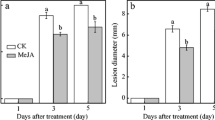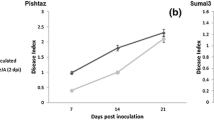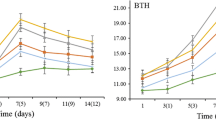Abstract
The effects of methyl jasmonate (MeJA) treatment on the mold decay and disease resistance of Ginkgo biloba seeds in response to pathogen attack were assessed. G. biloba seeds were exposed to different concentrations of MeJA vapor for 12 h before being inoculated with Penicillium oxalicum. Results showed that MeJA at different concentrations could markedly decrease the disease incidence and inhibit membrane damage of G. biloba seeds compared with the control, especially at the concentrations of 100 and 150 μmol L−1. The H2O2 content and activities of H2O2-metabolising related enzymes were induced to a higher level with MeJA. Defense related enzyme activities were also significantly enhanced in G. biloba seeds treated with 100 and 150 μmol L−1 of MeJA. These results together indicated that MeJA stimulated the disease resistance of G. biloba seeds by regulating the activation of H2O2 accumulation and inducing activities of defense-related enzymes.







Similar content being viewed by others
References
W. Huang, Q. Deng, B. Xie et al., Purification and characterization of an antioxidant protein from Ginkgo biloba seeds. Food Res. Int. 43, 86–94 (2010)
P.D. Tredici, Ginkgos and people - a thousand years of interaction. Arnoldia. 51, 2–15 (1991)
D.O. Kennedy, A.B. Scholey, K.A. Wesnes, The dose-dependent cognitive effects of acute administration of Ginkgo biloba to healthy young volunteers. Psychopharmacology. 151, 416–423 (2000)
K. Nakanishi, Terpene trilactones from Gingko biloba: from ancient times to the 21st century. Bioorgan. Med. Chem. 13, 4987–5000 (2005)
J. Polich, R. Gloria, Cognitive effects of a Ginkgo biloba/vinpocetine compound in normal adults: systematic assessment of perception, attention and memory. Hum. Psychopharm Clin. 16, 409–416 (2001)
S. Cao, Y. Zheng, Z. Yang et al., Effect of methyl jasmonate on the inhibition of Colletotrichum acutatum infection in loquat fruit and the possible mechanisms. Postharvest Biol. Tec. 49, 301–307 (2008)
M. Glowacz, D. Rees, Using jasmonates and salicylates to reduce losses within the fruit supply chain. Eur. Food Res. Technol. 242, 143–156 (2016)
M. Glowacz, N. Roets, D. Sivakumar, Control of anthracnose disease via increased activity of defence related enzymes in ‘Hass’ avocado fruit treated with methyl jasmonate and methyl salicylate. Food Chem. 234, 163–167 (2017)
L. Wang, P. Jin, J. Wang, Methyl jasmonate primed defense responses against Penicillium expansum in sweet cherry fruit. Plant Mol. Biol. Rep. 33, 1464–1471 (2015)
F. Tian, W.L. Chen, G.J. Fan et al., Effect of Ginkgo biloba seed exopleura extract and chitosan coating on the postharvest quality of ginkgo seed. J. Sci. Food Agr. 99, 3124–3133 (2019)
F. Tian, W.L. Chen, C.E. Wu et al., Preservation of Ginkgo biloba seeds by coating with chitosan/nano-TiO2 and chitosan/nano-SiO2 films. Int. J. Biol. Macromol. 126, 917–925 (2019)
Y. Li, C.E. Wu, G.J. Fan et al., Antimicrobial and preservative effects of natamycin on ginkgo fruits. Food. Sci. 35, 220–225 (2014)
G. Romanazzi, S.M. Sanzani, Y. Bi et al., Induced resistance to control postharvest decay of fruit and vegetables. Postharvest Biol. Tec. 122, 82–94 (2016)
R.A. Creelman, J.E. Mullet, Biosynthesis and action of jasmonates in plants. Annu. Rev. Plant Physiol. Plant Mol Biol Rep. 48, 355–381 (1997)
C. Ding, C. Wang, K.C. Gross et al., Reduction of chilling injury and transcript accumulation of heat shock proteins in tomato fruit by methyl jasmonate and methyl salicylate. Plant Sci. 161, 1153–1159 (2001)
L. Jiang, P. Jin, L. Wang et al., Methyl jasmonate primes defense responses against Botrytis cinerea and reduces disease development in harvested table grapes. Sci. Hortic. 192, 218–223 (2015)
L. bvEbrahimi, H.R. Etebarian, H. Aminian et al., Effect of Metschnikowia pulcherrima and methyl jasmonate on apple blue; mold disease and the possible mechanisms involved. Phytoparasitica. 41, 515–519 (2013)
H. Zhang, L. Ma, M. Turner et al., Methyl jasmonate enhances biocontrol efficacy of Rhodotorula glutinis to postharvest blue mold decay of pears. Food Chem. 117, 621–626 (2009)
H.J. Yao, S.P. Tian, Effects of a biocontrol agent and methyl jasmonate on postharvest diseases of peach fruit and the possible mechanisms involved. J. Appl. Microbiol. 98, 941–950 (2005)
M.J. Giménez, J.M. Valverde, D. Valero et al., Postharvest methyl salicylate treatments delay ripening and maintain quality attributes and antioxidant compounds of ‘Early Lory’ sweet cherry. Postharvest Biol. Tec. 117, 102–109 (2016)
J.Y. Chen, L.H. He, Y.M. Jiang et al., Role of phenylalanine ammonia-lyase in heat pretreatment-induced chilling tolerance in banana fruit. Physiol. Plant. 132, 318–328 (2008)
G. Yuan, B. Sun, J. Yuan et al., Effect of 1-methylcyclopropene on shelf life, visual quality, antioxidant enzymes and health-promoting compounds in broccoli florets. Food Chem. 118, 774–781 (2010)
B. Patterson, E. Mackae, I. Ferguson, Estimation of hydrogen peroxide in plant extracts using titanium(IV). Anal. Biochem. 139, 487–492 (1984)
S. Lurie, E. Fallik, A. Handros et al., The possible involvement of peroxidase in resistance to Botrytis cinerea in heat treated tomato fruit. Physiol. Mol. Plant. 50, 141–149 (1997)
M.V. Rao, G. Paliyath, D.P. Ormrod, Ultraviolet-B- and ozone-induced biochemical changes in antioxidant enzymes of Arabidopsis thaliana. J. Plant Physiol. 110, 125–136 (1996)
B. Chance, A.C. Maehly, Assay of catalases and peroxidases. Method Enzymol. 2, 764–775 (1955)
J.S. Assis, R. Maldonado, T. Muñoz et al., Effect of high carbon dioxide concentration on PAL activity and phenolic contents in ripening cherimoya fruit. Postharvest Biol. Tec. 23, 33–39 (2001)
F.B. Abeles, R.P. Bosshart, L.E. Forrence et al., Preparation and purification of glucanase and chitinase from bean leaves. Plant Physiol. 47, 129–134 (1971)
P.S. Sellamuthu, D. Sivakumar, P. Soundy et al., Essential oil vapours suppress the development of anthracnose and enhance defence related and antioxidant enzyme activities in avocado fruit. Postharvest Biol. Tec. 81, 66–72 (2013)
P. Jin, Y. Zheng, S. Tang et al., Enhancing disease resistance in peach fruit with methyl jasmonate. J. Sci. Food Agr. 89, 802–808 (2009)
J. Guo, W. Fang, H. Lu et al., Inhibition of green mold disease in mandarins by preventive applications of methyl jasmonate and antagonistic yeast Cryptococcus laurentii. Postharvest Biol. Tec. 88, 72–78 (2014)
H. Yao, S. Tian, Effects of pre- and post-harvest application of salicylic acid or methyl jasmonate on inducing disease resistance of sweet cherry fruit in storage. Postharvest Biol. Tec. 35, 253–262 (2005)
M. Rehman, Z. Singh, T. Khurshid, Methyl jasmonate alleviates chilling injury and regulates fruit quality in ‘Midknight’ Valencia orange. Postharvest Biol. Tec. 141, 58–62 (2018)
C.L. Wilson, A.E. Ghaouth, E. Chalutz et al., Potential of induced resistance to control postharvest diseases of fruits and vegetables. Plant Dis. 78, 837–844 (1994)
J. Kuć, Concepts and direction of induced systemic resistance in plants and its application. Eur. J. Plant Pathol. 107, 7–12 (2001)
M.A. Torres, J.D.G. Jones, J.L. Dangl, Reactive oxygen species signaling in response to pathogens. Plant Physiol. 141, 373–378 (2006)
M.J. Tareen, N.A. Abbasi, I.A. Hafiz, Postharvest application of salicylic acid enhanced antioxidant enzyme activity and maintained quality of peach cv. ‘Flordaking’ fruit during storage. Sci. Hortic. 142, 221–228 (2012)
Acknowledgements
This research was financially supported by National Key R&D Program of China [2019YFD1002300], North Jiangsu Science and Technology Project [XZ-SZ201929], Research Project of Jiangxi Forestry Bureau [No.202012], Postgraduate Research & Practice Innovation Program of Jiangsu Province [No. KYCX17_0836]. The authors also acknowledged the support of Priority Academic Program Development of Jiangsu Higher Education Institutions [PAPD].
Author information
Authors and Affiliations
Corresponding author
Ethics declarations
Conflict of interest
All author delares that there is no conflict of interest to disclose.
Additional information
Publisher's Note
Springer Nature remains neutral with regard to jurisdictional claims in published maps and institutional affiliations.
Rights and permissions
Springer Nature or its licensor (e.g. a society or other partner) holds exclusive rights to this article under a publishing agreement with the author(s) or other rightsholder(s); author self-archiving of the accepted manuscript version of this article is solely governed by the terms of such publishing agreement and applicable law.
About this article
Cite this article
Tian, F., Wu, C., Kou, X. et al. Postharvest methyl jasmonate treatment inhibits blue mold decay in Ginkgo biloba seeds by inducing antioxidant and defense systems. Food Measure 17, 1199–1207 (2023). https://doi.org/10.1007/s11694-022-01662-1
Received:
Accepted:
Published:
Issue Date:
DOI: https://doi.org/10.1007/s11694-022-01662-1




